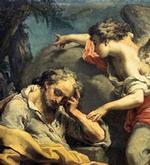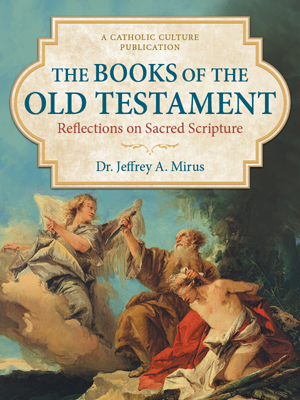The Nagasaki Martyrs
by Jay Copp
Some 200 bishops and priests followed the cross-bearer and the servers carrying 26 candles into the sports stadium. On this day, Feb. 5, 1997, there would be no games played here. On this day, the Church, and a nation, paused to remember 26 martyrs killed in Nagasaki four centuries before.
A congregation of more than 6,000 stood as the bones of three of the martyrs — St. Paul Miki, Diego Kisai and Joao Goto — were carried to the altar by three priests and incensed there by a papal envoy.
Among those watching and taking part were pilgrims from Australia, France, South Korea and Spain.
The anniversary Mass received unprecedented live television coverage in a country with a minuscule Catholic population (about 439,000 among more than
124 million people, or about one-third of 1 percent). Evening news slots were expanded to report on it.
If St. Paul Miki and his companions are not heroes in the eyes of most of their countrymen, at least they are no longer outcasts. And a televised Mass honoring them is only the latest chapter in the incredible story of Catholicism in the Land of the Rising Sun.
It's a story that began on the feast of the Assumption 448 years ago, Aug. 15, 1549, when Francis Xavier and two fellow Jesuits stepped from their ship in Kagoshima harbor and quickly waded ashore — the first missionaries to Japan.
Before them lay a civilized country that knew nothing of Christ. A short time later Father Xavier (now St. Francis Xavier, feast day Dec. 3) wrote, "These are the best people so far discovered, and it seems to me that among unbelievers no people can be found to excel them."
The Jesuits and later the Franciscans courageously spread the Gospel in Japan and converted nearly 500,000. A land of Buddhist temples became dotted with Christian churches. Large numbers of Japanese became catechists, and a seminary produced native clergy.
Yet fortunes turned on the missionaries. In 1597, Christianity was banned, and the 26 martyrs perished in Nagasaki. For decades Japanese soil was stained with the blood of Christian martyrs who clung to their faith despite bitterly cruel persecution.
What went right, and what went wrong?
After Portuguese seafarers had accidentally landed ashore Japan in 1542, the Jesuits quickly set their sights on the new land. At that time the Society of Jesus was a new order, having been founded only eight years earlier. Its members would soon distinguish themselves for their strict discipline, unwavering loyalty to the pope and fearless promotion of the faith. Before sailing to Japan from India, St. Francis, who was a Basque, wrote in a letter that he did not fear shipwreck or pirates, but the anger of God if he were not diligent in his service.
At that time, Japan was torn by constant strife among its dozens of feudal warlords. Some Japanese who lived under the close protection of the warlords enjoyed the fruits of education and wealth, but peasants in the countryside, oppressed by their feudal masters, were desperately poor. Buddhism was the primary religion, though Shintoism also claimed adherents.
St. Francis received a friendly reception from one of the more powerful lords. He was allowed to preach and convert. The priest's sterling character was pivotal to his success. The lords and their ministers were taken by the strength of his convictions. Influential monks visited by St. Francis also were charmed by his simplicity and piety.
Political factors worked in St. Francis' favor, too. Merchants and cargo ships followed the Jesuits into Japan, and the shoguns — warlords — made sure they profited from the commerce.
The lords' disdain of Buddhist monks further helps explain the success of the missions. Some of the monks took sides and sometimes even took up arms in the various conflicts. The lords saw the spread of Christianity as diminishing the power of the monks.
During his two years in Japan, St. Francis oversaw the conversion of 1,000 Japanese and laid the groundwork for the Jesuits who replaced him. Eager to proselytize in China, he left Japan in 1551. St. Francis later wrote that, in many respects, the Japanese were superior to Europeans and referred to them as "the delight of my heart."
The Jesuits who came after St. Francis, particularly Fathers Luis Frois and Alexander Valignano, followed St. Francis' strategy and made inroads with some of shoguns' most trusted men, converting them and paving the way for evangelization among the masses.
Christianity grew quickly after 1569 when Nobunaga, a warlord who had triumphed over his rivals and consolidated power, issued an edict that gave the Jesuits a relatively free hand. Befriended by Father Frois, he even gave the Jesuits a large tract of land and promised them an annual sum of money.
Converting the Japanese was no small feat. Their Buddhist faith was a vital part of their culture, and in the wider community accepting Christianity was viewed as a repudiation of their heritage. Yet by 1580, the Church in Japan counted 150,000 converts at 200 churches. Just 85 Jesuits were ministering in Japan. Their small numbers and large accomplishments were a testimony not only to the power of the Gospel message, but also to the skill and tenacity of its messengers.
The Jesuits' respect for Japanese culture also contributed to their success. As much as possible, the clergy observed local etiquette and customs. They addressed the various classes properly. They served saki to guests. They gave gifts when appropriate. They avoided loud laughter or boisterous behavior — which was a sign of a lack of self-control to the Japanese. Most importantly, the missionaries learned and used the Japanese language.
But the tide turned on the missionaries. They had been allowed to proselytize due to political reasons, and politics now worked against them. Disturbed by the growing influence of Christianity, Hideyoshi, Nobunaga's successor, felt compelled to placate the Buddhist monks. Overly fanatical Christians also had not done themselves any favors: they had burned some temples before building churches. In 1587, Hideyoshi suddenly ordered Christians to leave Japan within 20 days.
But distracted by foreign intrigues, Hideyoshi never actually enforced his ban, and nearly all the missionaries stayed on. With much more discretion, they quietly continued evangelization. Japan eventually counted 300,000 to 500,000 Catholics among a population of 25 million. "It's difficult if not impossible to find another highly civilized pagan country where Christianity had made such a mark," wrote historian C.R. Boxer.
Yet the Church itself was sometimes its own worst enemy there. The Jesuits and Franciscans engaged in a bitter rivalry. The Portuguese Jesuits, distrustful of the Spanish Franciscans, had insisted they not enter Japan. But the Franciscans began arriving in 1593 and unwisely openly flouted the official ban on Christianity by preaching and baptizing in the capital city under the nose of Hideyoshi.
Besides antagonizing the authorities, the Franciscans — obviously on unfriendly terms with the Jesuits — confused the Japanese, who often discounted Buddhism because of its numerous rivaling sects. The appearance of the Franciscans seemed to water down the authority of the Jesuits' teaching. Still, the Church grew steadily despite internal conflict and the constant threat of persecution.
During this time, any political instability posed a danger to Christians. In Nagasaki in 1597, the threat became horribly real. Twenty-six priests and lay Catholics were rounded up and publicly mutilated by having their ears and noses cut off. Then they were crucified.
The martyrdom was prompted by a rash remark by the captain of a Spanish ship. But on a deeper level, the deaths were the result of the danger of professing the Christian faith in a Buddhist country torn by internal war and fear of foreign conquest.
The captain's ship, the heavily loaded San Felipe, was wrecked on the Japanese coast. The despot Hideyoshi ordered his officers to confiscate the ship and its goods. The captain angrily showed the officers a map of the world and pointed to the vast empire under control of Spain. He recklessly added that the Spaniards used merchants and priests as an advance guard before sending their conquistadors.
Hideyoshi, wary of any real or imagined threat to his power, was furious.
Crucified at Nagasaki were six Spanish Franciscans, 17 Japanese and Korean catechists and three Japanese Jesuits — a priest and two brothers. Among the group were three young boys who had been altar servers. In addition to the deaths, 130 churches were burned down.
Unfortunately, the events further divided the Franciscans and Jesuits. Emotions ran high, and the Franciscans even claimed that the Jesuits had entertained the judges who decided the fate of the martyrs. Relations remained considerably strained until countrywide persecutions began in 1614, and the two orders put aside most of their differences.
The Nagasaki martyrs were canonized in 1862. The feast day for "Paul Miki and Companions" is Feb. 6.
Today, the Shrine of the 26 Martyrs in Nagasaki marks the site of the execution. The Japanese government, mindful that most of the victims were Japanese, recognizes it as a national monument.
Money taken up during a collection at the anniversary Mass in Nagasaki this year was donated to the city to refurbish it.
© Our Sunday Visitor
This item 4024 digitally provided courtesy of CatholicCulture.org






